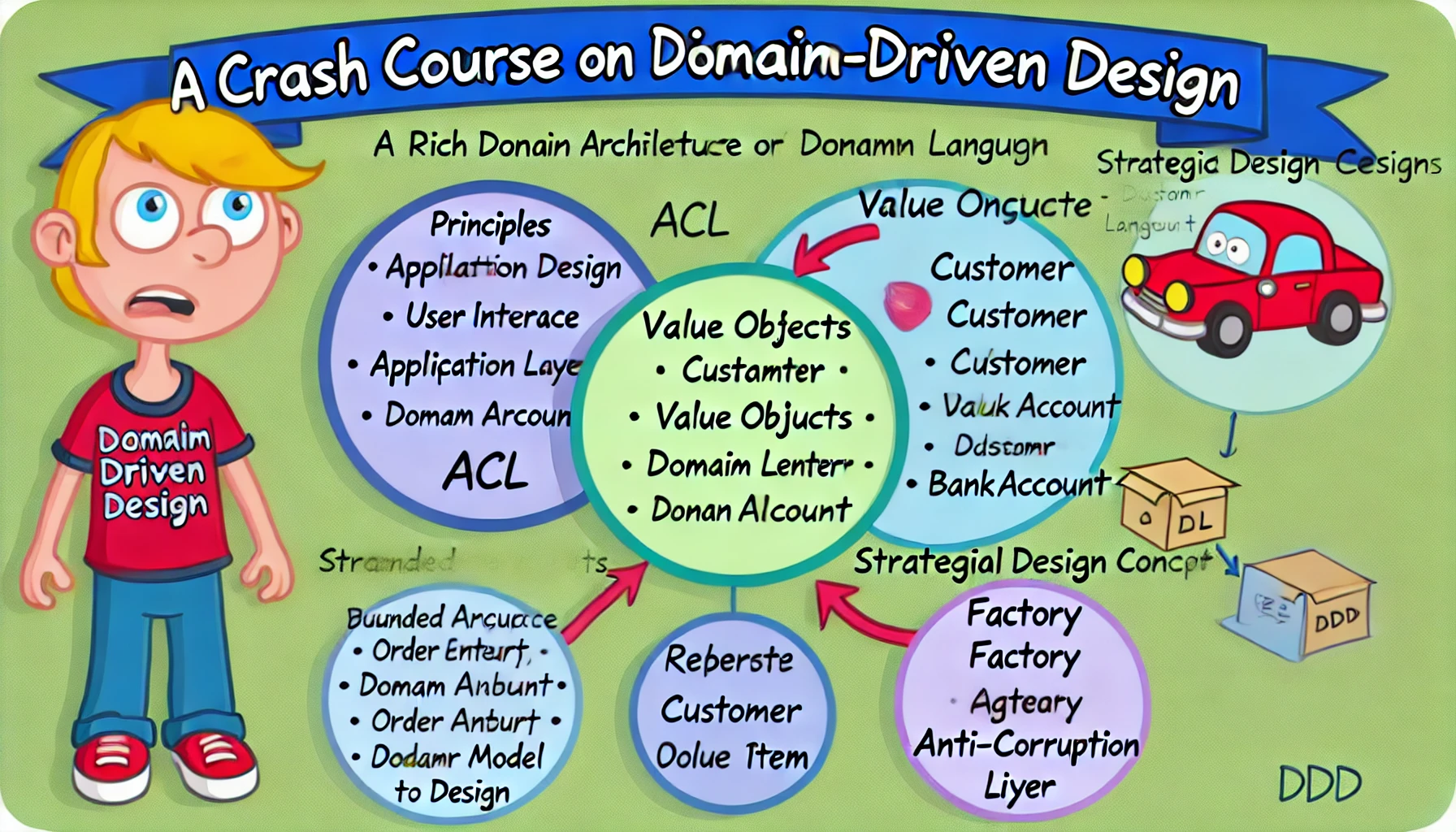Introduction to Domain-Driven Design
领域驱动设计简介
Creating software for intricate domains is a demanding endeavor.
为复杂领域开发软件是一项艰巨的任务。
As the intricacy of the problem domain increases, it becomes more challenging to design software that accurately reflects business concepts, rules, and processes.
随着问题领域复杂性的增加,设计能够准确反映业务概念、规则和流程的软件变得更加具有挑战性。
Poorly constructed software can quickly devolve into an unmanageable jumble of code that is hard to comprehend, maintain, and enhance.
设计不良的软件很快就会演变成一团难以管理的代码,难以理解、维护和改进。
Domain-Driven Design (DDD) provides a framework to address this issue.
领域驱动设计 (DDD) 提供了一个解决这一问题的框架。
What is Domain-Driven Design?
什么是领域驱动设计?
DDD is a methodology for software development that addresses domain complexity by focusing on the importance of modeling the core domain and business logic, using these models as the basis for software design.
DDD 是一种软件开发方法,通过关注建模核心领域和业务逻辑的重要性来解决领域复杂性,并以这些模型作为软件设计的基础。
Fundamentally, Domain-Driven Design involves:
从根本上说,领域驱动设计包括:
-
Concentrating primarily on the core domain.
-
主要关注核心领域。
-
Developing complex designs based on a domain model.
-
基于领域模型进行复杂设计。
-
Promoting collaboration between technical and domain experts.
-
促进技术专家与领域专家之间的合作。
The Importance of Domain-Driven Design
领域驱动设计的重要性
The importance of Domain-Driven Design has grown in recent years.
近年来,领域驱动设计的重要性日益增加。
Microservices and cloud computing architectures have led to systems comprised of many small, interacting components.
微服务和云计算架构导致系统由许多小的、交互的组件组成。
Without a clear and well-defined domain model guiding their design, these systems can quickly become disorganized.
如果没有一个清晰且定义良好的领域模型来指导其设计,这些系统很快就会变得杂乱无章。
Core Concepts of Domain-Driven Design
领域驱动设计的核心概念
In this discussion, we will explore the basic principles of Domain-Driven Design and its essential concepts that help create maintainable and scalable systems aligned with the core domain and business logic.
在本讨论中,我们将探讨领域驱动设计的基本原则及其关键概念,这些概念有助于创建与核心领域和业务逻辑保持一致的可维护和可扩展的系统。
1. Ubiquitous Language
1. 通用语言
A fundamental aspect of DDD is establishing a ubiquitous language—a common language shared by developers and domain experts.
DDD 的一个基本方面是建立一种通用语言,即开发人员和领域专家共享的一种语言。
This language is derived from the business domain and is consistently used by all team members.
这种语言源自业务领域,并由所有团队成员一致使用。
It ensures that the software accurately represents business processes and minimizes misunderstandings.
它确保软件准确表示业务流程,并最大限度地减少误解。
2. Entities and Value Objects
2. 实体和值对象
- Entities: These are objects with a distinct identity that persists through different states and over time.
- 实体:这些对象具有独特的身份,贯穿于不同状态和时间。
For instance, a customer in a banking system is an entity due to its unique identity.
例如,银行系统中的客户是一个实体,因为它具有唯一的身份。
- Value Objects: These objects are defined only by their attributes and do not have a distinct identity.
- 值对象:这些对象仅由其属性定义,没有独特的身份。
An address, for example, can be a value object.
例如,地址可以是一个值对象。
3. Aggregates
3. 聚合
Aggregates are clusters of domain objects treated as a single unit.
聚合是作为单一单元处理的领域对象集群。
Each aggregate has a root, known as the aggregate root, which is the only member of the aggregate that can be referenced directly by external objects.
每个聚合都有一个根,称为聚合根,这是外部对象可以直接引用的聚合唯一成员。
4. Repositories
4. 仓储
Repositories encapsulate the set of objects persisted in a data store and the operations performed on them, providing an in-memory collection-like interface for accessing domain objects.
仓储封装在数据存储中持久化的一组对象及其上执行的操作,为访问领域对象提供类内存集合接口。
5. Factories
5. 工厂
Factories are responsible for creating complex objects.
工厂负责创建复杂对象。
They encapsulate the necessary knowledge to create an object and can produce a fully formed aggregate with all invariants satisfied.
它们封装了创建对象所需的知识,并可以生成一个满足所有不变量的完整聚合。
Strategic Design Concepts
战略设计概念
To manage extensive models and teams, DDD introduces strategic design concepts:
为了管理大型模型和团队,DDD 引入了战略设计概念:
- Bounded Contexts: These define the boundaries within which a particular model is applicable.
- 限界上下文:定义特定模型适用的边界。
Different system parts may have different models, but each model is consistent within its bounded context.
系统的不同部分可能有不同的模型,但每个模型在其限界上下文内是一致的。
-
Shared Kernel: A shared subset of the domain model used by multiple bounded contexts.
-
共享核心:多个限界上下文使用的领域模型的共享子集。
-
Anti-Corruption Layer: This serves as a translator between different models to ensure one model does not corrupt another.
-
防腐层:作为不同模型之间的翻译器,确保一个模型不会破坏另一个模型。
Conclusion
结论
Domain-Driven Design is a robust approach to handling the complexity of software development in complex domains.
领域驱动设计是一种应对复杂领域软件开发复杂性的强大方法。
By concentrating on the core domain, promoting collaboration between technical and domain experts, and employing a well-defined domain model, DDD helps in building systems that are maintainable and scalable.
通过专注于核心领域、促进技术专家与领域专家之间的合作以及采用定义明确的领域模型,DDD 有助于构建可维护和可扩展的系统。
Adopting DDD can lead to more robust and scalable architectures, particularly in the era of microservices and cloud computing.
采用 DDD 可以带来更健壮和可扩展的架构,特别是在微服务和云计算时代。
As software development continues to evolve, the principles of DDD remain vital in guiding the design and development of complex systems.
随着软件开发的不断演变,DDD 的原则在指导复杂系统的设计和开发方面仍然至关重要。

Leave a Reply